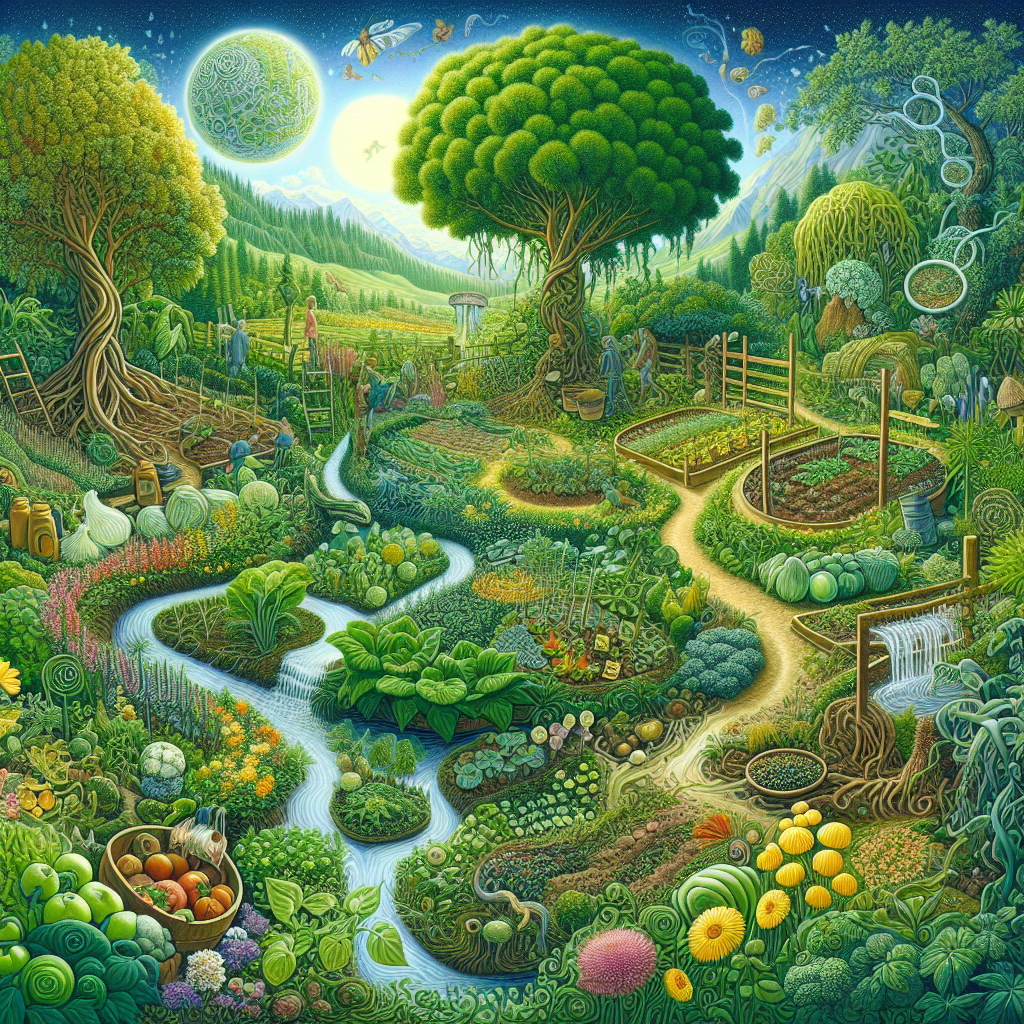The Ultimate Permaculture Beginners Guide: Start Your Sustainable Journey Today

Starting a permaculture garden can be a rewarding way to live more sustainably. This guide will help you understand the basics of permaculture, design your garden, and choose the right plants. You'll also learn about soil health, sustainable practices, and how to maintain your garden. Let's begin your journey towards a greener, more self-sufficient lifestyle.
Key Takeaways
- Permaculture combines natural ecosystems with sustainable agriculture.
- Designing your garden involves careful planning and site assessment.
- Choosing native plants can boost your garden's health and biodiversity.
- Healthy soil and composting are crucial for plant growth.
- Sustainable practices like water conservation and using renewable resources are vital.
Understanding the Basics of Permaculture
What is Permaculture?
Permaculture is more than just a method of gardening; it’s a revolutionary approach to living in balance with our environment. This philosophy, developed by visionaries like Bill Mollison and David Holmgren, provides a framework for sustainable living and ecological design that respects the natural world. The World Permaculture Association proudly follows in their footsteps, offering a wealth of knowledge through free resources.
Core Principles of Permaculture
The three principles of permaculture are earth care, people care, and fair share, which are the foundational ethics for permaculture design and can also be found in many traditional societies. These ethics help regulate self-interest and give us a greater understanding of good and bad outcomes.
Benefits of Permaculture Gardening
Permaculture gardening offers numerous benefits, including reduced waste, improved soil health, and increased biodiversity. By mimicking natural ecosystems, permaculture gardens require less maintenance and provide a more sustainable way to grow food. Starting your permaculture journey can lead to a healthier lifestyle and a more resilient environment.
Designing Your Permaculture Garden
Site Assessment and Planning
Before you start planting, it's crucial to understand your garden's unique characteristics. Assessing your site involves observing sunlight, wind patterns, and soil type. Take note of any existing vegetation and water sources. This information will help you plan a garden that's in harmony with nature.
Creating Zones and Sectors
In permaculture, your garden is divided into zones based on how often you visit them. Zone 1 is closest to your home and includes plants you use daily, like herbs. Zone 5 is the wildest area, left mostly untouched. This zoning helps you manage your garden efficiently.
Water Management Techniques
Water is a precious resource, and managing it wisely is key to a successful permaculture garden. Techniques like rainwater harvesting and swales can help you make the most of natural rainfall. By designing your garden to capture and store water, you ensure that your plants stay hydrated even during dry spells.
Embrace greener habits for beginners by incorporating these water management techniques into your garden design. You'll be amazed at how much water you can save and how healthy your plants will be.
Choosing the Right Plants for Your Garden
Native Plants and Their Benefits
Native plants are a fantastic choice for your permaculture garden. They are well-adapted to the local climate and soil, making them easier to care for. Native plants also support local wildlife, providing food and habitat for birds, insects, and other creatures. By choosing native species, you help maintain the natural ecosystem and promote biodiversity.
Companion Planting Strategies
Companion planting is a permaculture technique where different plants are grown together to benefit each other. For example, planting basil near tomatoes can improve the flavor of the tomatoes and repel pests. Here are some popular companion planting pairs:
- Tomatoes and Basil: Basil repels pests and enhances tomato flavor.
- Carrots and Onions: Onions deter carrot flies.
- Beans and Corn: Beans fix nitrogen in the soil, benefiting corn.
This method not only boosts plant health but also increases your garden's yield.
Perennial vs. Annual Plants
When planning your garden, it's essential to understand the difference between perennial and annual plants. Perennials live for several years, coming back each season, while annuals complete their life cycle in one year. Perennial plants are great for creating a stable, low-maintenance garden. They often have deep root systems that improve soil structure and water retention. Annuals, on the other hand, are perfect for adding variety and quick yields to your garden.
By mixing perennials and annuals, you can enjoy the benefits of both: a stable garden structure and a variety of crops throughout the year.
Choosing the right plants for your garden is a crucial step in building a successful permaculture system. With thoughtful selection and planning, your garden will thrive and provide you with bountiful harvests year after year.
Soil Health and Composting

Building Healthy Soil
Healthy soil is the foundation of a thriving permaculture garden. Rich, fertile soil supports plant growth and helps retain moisture. To build healthy soil, start by adding organic matter like compost, which improves soil structure and tilth. Regularly test your soil to understand its pH and nutrient levels, and adjust as needed with natural amendments.
Composting Methods
Composting is a fantastic way to recycle waste and create nutrient-rich soil. There are several methods to choose from:
- Cold Composting: Simply pile up your organic waste and let it decompose over time.
- Hot Composting: Requires turning the pile regularly to speed up decomposition.
- Vermicomposting: Uses worms to break down food scraps quickly.
Each method has its benefits, so choose the one that fits your lifestyle and garden needs.
Natural Fertilizers and Amendments
Using natural fertilizers and amendments can boost your soil's fertility without harming the environment. Some great options include:
- Compost: Adds essential nutrients and improves soil structure.
- Manure: Rich in nitrogen, it helps plants grow strong and healthy.
- Bone Meal: Provides phosphorus, which is crucial for root development.
- Green Manure: Planting cover crops that are later turned into the soil to add organic matter.
Remember, healthy soil leads to healthy plants. By focusing on soil health, you're setting your garden up for success.
Incorporating these practices will not only improve your garden's productivity but also contribute to a more sustainable and eco-friendly environment.
Sustainable Practices in Permaculture
Water Conservation Techniques
Water is a precious resource, and conserving it is crucial for a sustainable garden. Collecting rainwater is a simple yet effective way to reduce your water usage. You can set up rain barrels to capture runoff from your roof. Additionally, using mulch around your plants helps retain soil moisture, reducing the need for frequent watering.
Using Renewable Resources
In permaculture, the goal is to use resources that can be replenished naturally. Solar energy is a fantastic example. Installing solar panels can provide clean energy for your garden tools and lighting. Composting is another way to recycle organic waste into valuable nutrients for your soil, closing the loop on waste.
Creating Wildlife Habitats
A thriving permaculture garden supports not just plants but also wildlife. By planting native species, you create a habitat for local birds, insects, and other animals. This biodiversity helps control pests naturally and promotes a balanced ecosystem. Consider adding birdhouses, bat boxes, and insect hotels to encourage wildlife to make your garden their home.
Embracing these sustainable practices not only benefits your garden but also contributes to a healthier planet. By making small changes, you can create a big impact on the environment.
Maintaining Your Permaculture Garden
Seasonal Tasks and Tips
Keeping your permaculture garden thriving requires some seasonal tasks. In spring, focus on planting and mulching. Summer is all about watering and weeding. Fall is the time to harvest and prepare your garden for winter. Winter is perfect for planning and maintaining your tools. By following these seasonal tips, your garden will stay healthy year-round.
Pest and Disease Management
Regularly check your plants for signs of pests or diseases. Look for discolored leaves, wilting, or insect damage. If you spot any issues, act quickly to treat the problem. Use natural remedies like neem oil or introduce beneficial insects to keep pests in check. Staying on top of these tasks ensures a vibrant garden.
Harvesting and Storing Your Produce
Harvest your produce when it's ripe for the best flavor and nutrition. Use a sharp knife or scissors to avoid damaging the plants. Store your harvest in a cool, dry place. Some vegetables can be frozen or canned for longer storage. Proper storage helps you enjoy your garden's bounty all year long.
Consistent maintenance is key to a successful permaculture garden. By staying proactive, you can enjoy a thriving, sustainable garden that provides fresh produce and beauty throughout the seasons.
Conclusion
Starting your permaculture journey is like planting the first seed in a garden that will grow and flourish for years to come. With the tips and knowledge shared in this guide, you're well on your way to creating a sustainable and productive garden. Remember, every small step you take contributes to a healthier planet. So, get out there, get your hands dirty, and enjoy the process of learning and growing. Happy gardening!
Frequently Asked Questions
What is permaculture?
Permaculture is a way of designing gardens that mimic natural ecosystems. It focuses on sustainability, using resources wisely, and creating a balanced environment.
What are the core principles of permaculture?
The main principles of permaculture include observing and interacting with nature, catching and storing energy, obtaining a yield, applying self-regulation, using renewable resources, producing no waste, and valuing diversity.
How do I start a permaculture garden?
Begin by assessing your site to understand its unique characteristics. Plan your garden layout, considering zones and sectors. Choose native plants, plan for water management, and start improving your soil with composting.
What are the benefits of permaculture gardening?
Permaculture gardening is eco-friendly, reduces waste, conserves water, and creates habitats for wildlife. It also provides fresh, organic produce and can save money in the long run.
Can I practice permaculture in a small space?
Yes, you can practice permaculture even in small spaces. Use vertical gardening, container gardening, and choose plants that are suitable for small areas. Focus on maximizing the use of available space efficiently.
What is the difference between annual and perennial plants?
Annual plants complete their life cycle in one growing season and need to be replanted each year. Perennial plants live for multiple years, regrowing each season without needing to be replanted.
